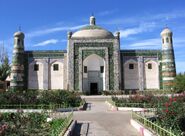Template:Infobox Civ The Sufi Mosque is a native Asian settlement featured in Age of Empires III: The Asian Dynasties. Like all natives, they can be allied with by building a Trading Post at their Trading Post site.
The Sufi Mosque is available on the Borneo, Deccan, Indochina, Mongolia and Silk Road maps.
Unit

War Elephant
War Elephant: The most powerful native unit in Age of Empires III on its own (it is like a weaker version of the Mahout Lancer), it possesses a very high health and a high melee attack, making it powerful Heavy Cavalry, although it has weak resistances.
However, because of the low build limit of 6 per settlement, the use of War Elephants is limited. In fact, it has the lowest build limit among the standard native soldiers, superseded only by the Medicine Man of the Maya, the Cree Coureur des Bois, and the Nootka War Chief. It is suggested to use War Elephants only as support, as they are expensive and could easily fall prey to heavy infantry if not covered.
Upgrades
| Age | Icon | Improvement | Cost | Effect |
|---|---|---|---|---|
| Pilgrimage | 100 food, 100 wood | Ships 1 Fattened Goat for every 2 minutes the game has passed, up to 30 minutes | ||
| Fasting | 100 food, 100 coin | Settlers/Villagers get -40% health but gather resources 10% faster | ||
| Sharia | 225 food, 225 coin | Settler/Villager build limit +10% | ||
| Sufi Discipline Training | 200 wood, 150 coin | Upgrades War Elephants to Disciplined | ||
| Sufi Honor Training | 400 wood, 300 coin | Upgrades War Elephants to Honored |
Usefulness
- Sharia works well for the Dutch, the French and the Japanese due to their lower villager limits.
- Note that with Fasting, Settlers/Villagers are quickly killed if attacked, making them more vulnerable and should be kept safe.
History
| “ | This Holy Site is identical to a Native Trade Site. Allying with Natives allows a player to train special Native units, usually warriors, and also grants access to a group of improvements to that tribe. Native units do not cost any population spaces, but can only be built in limited numbers. The word “sufi” first appeared in the 8th century and is considered to be a reference to the coarse wool garments worn by spiritual men who sought lives of spiritual harmony, free from bodily pleasure and in harmony with nature. The word “sufism” was first used in the 9th century, and became a blanket term for a variety of different forms of Islamic mysticism incorporating such disparate elements as Christian monasticism, gnosticism, and Indian mysticism. Because Sufism encompasses a number of belief systems, its origins can be linked to a wide range of geographic regions and periods. However, many consider Sufism to have begun with the practice of Shiite Muslims in the 7th century in what is now Iraq, although others claim that Sufism predates Islam and simply used the other religion as a vehicle for its teachings. Throughout its long history, Sufism has been criticized for its mystical elements. While it has made significant contributions to the spread of Islam and the development of Islamic culture, conservative Muslims still disagree with its abundance of non-Islamic customs. | ” |
Gallery
Trivia
- The Sufi Mosque resembles the Shrine of Ali mosque and overall it appears to be based on the architecture of Shiite mosques.
- In the Sufi Mosque you can see eldery figure which looks similar to the Brahmin, although there is no correlation between them.
Template:Civilizations (AoE3)






